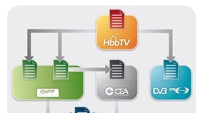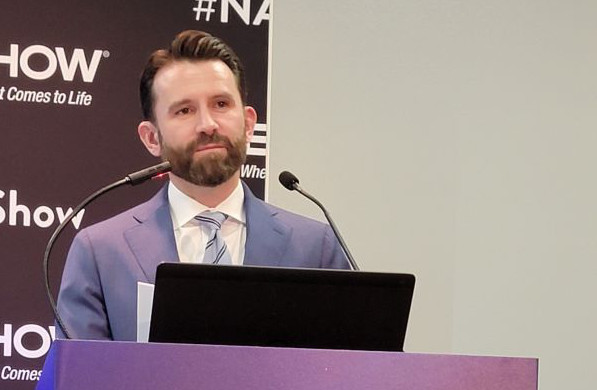Content portability and service interoperability key for OTT

The promise of OTT to serve the diverse platforms and customer profiles of multiple operators, broadcasters and content providers, while reaching all video playing devices, can only be met through consistent standards for service interoperability and content portability. This was one of the more hidden messages to emerge from NAB last week, where a number of vendors were parading one-stop, pre-integrated solutions for OTT deployment designed to provide a fast route to market and subsequent scalability. The need for such solutions highlighted the need for standards and components that enable OTT to become more plug-and-play, rather as the Digital Living Network Alliance (DLNA) is aiming to achieve within the connected home.
The DLNA is playing a role in OTT in terms of device interoperability and discovery, for example via the Universal Plug and Play (UPnP), but the greater task of establishing standards for OTT on a global scale has fallen to the body originally set up to coordinate development of specifications for end-to-end IPTV networks, the OIPF (Open IPTV Forum). This is because OTT is a natural extension of IPTV and many standards apply equally to both, such as the OIPF’s specifications for handover of channels or service sessions between devices, and simultaneous sharing of content between users, which also overlap with the DLNA’s remit.
But, OTT brings additional requirements, a fundamental one being to incorporate mobile broadband services, extending beyond the home, and, on this front, an important development was the merger between the OIPF and the Broadcast Mobile Convergence Forum (bmcoforum) announced in January. This meant the fixed and mobile broadband industries could meet under a single body to discuss OTT convergence issues. This, in turn, is leading to standard specifications for functions that require integration between mobile and fixed networks, such as use of cell phones as RCUs (Remote Control Units) for TV services.
Another important element of OTT is integration with linear broadcast services, with growing momentum here behind the HbbTV hybrid broadcast platform strongly promoted by the EBU. HbbTV is based on existing standards and web technologies including OIPF’s as well as W3C ones such as HTML5, and the DVB’s Application Signaling. The latest version 1.5 of HbbTV includes support for HTTP adaptive streaming based on MPEG-DASH, which improves video presentation quality on busy or slow Internet connections. It also enables content providers to protect MPEG DASH delivered content through multiple DRM technologies based on the MPEG CENC specification, which is a vital requirement for many OTT deployments where end devices are controlled by different DRMs.
But, there is a fundamental challenge remaining for the OIPF, which is to ensure that services themselves are interoperable and able to exchange content transparently between them. This is vital because OTT threatens to change the whole business ecosystem of relationships between content providers, broadcasters, pay TV operators and vendors of infrastructure related services such as CDNs (Content Delivery Networks). This calls for a coherent set of specifications and standards for an interoperable OTT Environment, allowing content-oriented relationships to flourish across service boundaries. We are already beginning to see these more complex relationships, for example, with Netflix delivering content through agreements it has negotiated over traditional pay TV platforms such as BSkyB in the UK. Many of the standards needed are already in place, but areas to be addressed include content portability, avoiding the need for use of ad hoc conversion technologies to translate between formats as at present. The OIPF has indicated that OTT service interoperability is now high on its agenda.
Standards will provide the framework for OTT interoperability, but do not guarantee that it will happen. This will need conformance testing, which is likely to play a bigger and more expansive role for OTT than for closed network IPTV deployments. This is because OTT has to embrace devices and platforms that are not under the operator’s direct control. A significant development, therefore, was the announcement in March 2012 of an automated OTT test suite by Digital TV Labs, which provides independent receiver conformance products and services. Called Ligada iSuite, this enables OTT operators to establish seamless delivery of services to multiple devices. It comprises an automated test suite covering HbbTV and OIPF as well as MPEG DASH adaptive streaming and various DRMs.
“In a traditional pay-TV environment, the operator normally tightly specifies, procures and tests a small number of bespoke set-top-boxes, thus guaranteeing interoperability,” Keith Potter, Digital TV Lans CEO, said at the launch. “In the fast-emerging OTT arena, the operator delivers applications and services to a mixed array of retail receivers. Ensuring a quality consumer experience to protect a brand, minimize churn and to keep support costs low is a major challenge for these connected TV operators.”
Get the TV Tech Newsletter
The professional video industry's #1 source for news, trends and product and tech information. Sign up below.
Digital TV Labs is making a strong play for HbbTV conformance testing, for which there is fast growing demand in Europe, and has said it will support country-specific HbbTV profiles as they emerge, such as the French TNT2.0 platform.
Many operators though, especially smaller ones, will not want to engage in conformance testing in order to step into OTT, and so there was great interest in pre-integrated platforms at NAB. Since only a few big vendors of OTT infrastructure, such as Cisco, Ericsson, Alcatel-Lucent and Huawei Telecom, have the resources to offer a complete, one-stop shop for OTT, including all components including transcoding, streaming and content security, other players in the ecosystem are clubbing together to offer pre-integrated platforms, sometimes with one vendor in a lead role. This was the case with the pre-integrated platform announced by Norwegian content security vendor Conax at NAB, offering a loosely-coupled approach where components from different partners can be slotted in to suit varying requirements. This is aimed at addressing the great OTT challenge of combining diversity and flexibility with interoperability and ease of deployment.
The promise of OTT to serve the diverse platforms and customer profiles of multiple operators, broadcasters and content providers, while reaching all video playing devices, can only be met through consistent standards for service interoperability and content portability. This was one of the more hidden messages to emerge from NAB last week, where a number of vendors were parading one-stop, pre-integrated solutions for OTT deployment designed to provide a fast route to market and subsequent scalability. The need for such solutions highlighted the need for standards and components that enable OTT to become more plug-and-play, rather as the Digital Living Network Alliance (DLNA) is aiming to achieve within the connected home.
The DLNA is playing a role in OTT in terms of device interoperability and discovery, for example via the Universal Plug and Play (UPnP), but the greater task of establishing standards for OTT on a global scale has fallen to the body originally set up to coordinate development of specifications for end-to-end IPTV networks, the OIPF (Open IPTV Forum). This is because OTT is a natural extension of IPTV and many standards apply equally to both, such as the OIPF’s specifications for handover of channels or service sessions between devices, and simultaneous sharing of content between users, which also overlap with the DLNA’s remit.
But, OTT brings additional requirements, a fundamental one being to incorporate mobile broadband services, extending beyond the home, and, on this front, an important development was the merger between the OIPF and the Broadcast Mobile Convergence Forum (bmcoforum) announced in January. This meant the fixed and mobile broadband industries could meet under a single body to discuss OTT convergence issues. This, in turn, is leading to standard specifications for functions that require integration between mobile and fixed networks, such as use of cell phones as RCUs (Remote Control Units) for TV services.
Another important element of OTT is integration with linear broadcast services, with growing momentum here behind the HbbTV hybrid broadcast platform strongly promoted by the EBU. HbbTV is based on existing standards and web technologies including OIPF’s as well as W3C ones such as HTML5, and the DVB’s Application Signaling. The latest version 1.5 of HbbTV includes support for HTTP adaptive streaming based on MPEG-DASH, which improves video presentation quality on busy or slow Internet connections. It also enables content providers to protect MPEG DASH delivered content through multiple DRM technologies based on the MPEG CENC specification, which is a vital requirement for many OTT deployments where end devices are controlled by different DRMs.
But, there is a fundamental challenge remaining for the OIPF, which is to ensure that services themselves are interoperable and able to exchange content transparently between them. This is vital because OTT threatens to change the whole business ecosystem of relationships between content providers, broadcasters, pay TV operators and vendors of infrastructure related services such as CDNs (Content Delivery Networks). This calls for a coherent set of specifications and standards for an interoperable OTT Environment, allowing content-oriented relationships to flourish across service boundaries. We are already beginning to see these more complex relationships, for example, with Netflix delivering content through agreements it has negotiated over traditional pay TV platforms such as BSkyB in the UK. Many of the standards needed are already in place, but areas to be addressed include content portability, avoiding the need for use of ad hoc conversion technologies to translate between formats as at present. The OIPF has indicated that OTT service interoperability is now high on its agenda.
Standards will provide the framework for OTT interoperability, but do not guarantee that it will happen. This will need conformance testing, which is likely to play a bigger and more expansive role for OTT than for closed network IPTV deployments. This is because OTT has to embrace devices and platforms that are not under the operator’s direct control. A significant development, therefore, was the announcement in March 2012 of an automated OTT test suite by Digital TV Labs, which provides independent receiver conformance products and services. Called Ligada iSuite, this enables OTT operators to establish seamless delivery of services to multiple devices. It comprises an automated test suite covering HbbTV and OIPF as well as MPEG DASH adaptive streaming and various DRMs.
"In a traditional pay-TV environment, the operator normally tightly specifies, procures and tests a small number of bespoke set-top-boxes, thus guaranteeing interoperability,” Keith Potter, Digital TV Lans CEO, said at the launch. “In the fast-emerging OTT arena, the operator delivers applications and services to a mixed array of retail receivers. Ensuring a quality consumer experience to protect a brand, minimize churn and to keep support costs low is a major challenge for these connected TV operators.”
Digital TV Labs is making a strong play for HbbTV conformance testing, for which there is fast growing demand in Europe, and has said it will support country-specific HbbTV profiles as they emerge, such as the French TNT2.0 platform.
Many operators though, especially smaller ones, will not want to engage in conformance testing in order to step into OTT, and so there was great interest in pre-integrated platforms at NAB. Since only a few big vendors of OTT infrastructure, such as Cisco, Ericsson, Alcatel-Lucent and Huawei Telecom, have the resources to offer a complete, one-stop shop for OTT, including all components including transcoding, streaming and content security, other players in the ecosystem are clubbing together to offer pre-integrated platforms, sometimes with one vendor in a lead role. This was the case with the pre-integrated platform announced by Norwegian content security vendor Conax at NAB, offering a loosely-coupled approach where components from different partners can be slotted in to suit varying requirements. This is aimed at addressing the great OTT challenge of combining diversity and flexibility with interoperability and ease of deployment.
